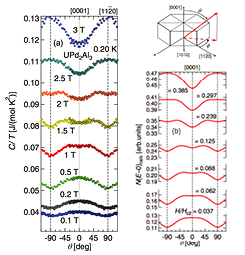Identification of the Superconducting Gap Structure of the Heavy-Fermion Antiferrmagnet UPd2Al3 by Angle-Resolved Heat Capacity Measurements
Sakakibara Group
The hexagonal heavy-fermion compound UPd2Al3 exhibits superconductivity below Tc = 2 K, which coexists with an antiferromagnetic ordering that sets in at TN = 14.5 K [1]. Various experiments including inelastic neutron scattering [2] and thermal conductivity [3] measurements have inferred that the superconducting gap function is of nodal A1g type, Δ(k) = Δ0cos(kzc), having horizontal line nodes. Up to present, however, no thermodynamic evidence for the horizontal line node has been obtained.

(a) Field-angle variation of C(H,θ)/T of UPd2Al3 with H rotated in the ac plane measured at 0.2 K. (b) Calculated results of the field-angle dependence of ZEDOS in magnetic fields normalized by Hc2 for a linear horizontal line node. The inset shows the definition of angles for the hexagonal structure.
In order to examine the pairing symmetry of UPd2Al3 in the light of quasiparticle density of states, we performed angle-resolved heat capacity (C) measurements on a high quality single crystal of UPd2Al3 in rotating magnetic fields (H) [4]. When H is rotated in the basal plane, no angular variation of C(H,ϕ) that could be ascribed to vertical line nodes is observed. To probe the horizontal line node, we examined the polar-angle (θ) dependence C(H,θ) and the results are shown in Fig. 1(a). Below 0.5 T, a twofold oscillation is clearly observed with a maximum at θ = 0˚ (H||[0001]) and a minimum at θ = 90˚ (H||[1120]). Above 2.5 T, the twofold angular oscillation is reversed and the maximum appears along [1120], reflecting the underlying nodal structure as well as the anisotropy of the upper critical field Hc2. Very interestingly, in the field range from 1 to 2 T, a new feature appears in C(H,θ) in an intermediate angle region; at 1 T, a shoulder or a hump appears at θ ~ 30˚, and moves to the higher angle side θ ~ 45˚-60˚ with increasing H to 2 T. Above 2.5 T, it finally merges into the maximum at θ = 90˚ arising from the Hc2 anisotropy. Remarkably, the maximum of C(H,θ)/T at 1.5 T occurs near 45˚.
The observed field evolution of C(H,θ), in particular the shoulder/hump structure in the intermediate angular region, provides strong evidence that a horizontal line node exists on the Fermi surface. We performed microscopic calculations of the zero-energy density of states (ZEDOS) by means of the quasiclassical Eilenberger theory within the Kramer-Pesch approximation [4]. Figure 1(b) shows the calculated angular dependence of ZEDOS, assuming a spherical Fermi surface and a model gap function ∆(k) = ∆0kz that has a horizontal line node at the equator. The results clearly demonstrate that the anisotropy inversion occurs in the ZEDOS as H increases. What is more important is that the calculated results successfully reproduce the shoulder/hump anomaly around 30-60˚ in C(H,θ) at the intermediate fields. The polar angle dependence of C(H,θ), therefore, possesses sufficiently high resolution to detect the horizontal line node.
References
- [1] C. Geibel et al., Z. Phys. B Condens. Matt. 84, 1 (1991).
- [2] N. Bernhoeft et al., Phys. Rev. Lett. 81, 4244 (1998).
- [3] T. Watanabe et al., Phys. Rev. B 70, 184502 (2004).
- [4] Y. Shimizu et al., Phys. Rev. Lett. 117, 037001 (2016).
